
11 minute read
GREENLAND
Cold-water-diving expert Byron Conroy left his adopted home of Iceland to explore the freezing waters of Greenland and its ‘population’ of monstrous icebergs

Advertisement
Photography Byron Conroy
Every year, the sun does not set from 25 May to 25 July, and it stays visible throughout the entire day and night. This phenomenon – called the ‘midnight sun’ in Greenland– needs to be experienced by everyone at least once in their lifetime.
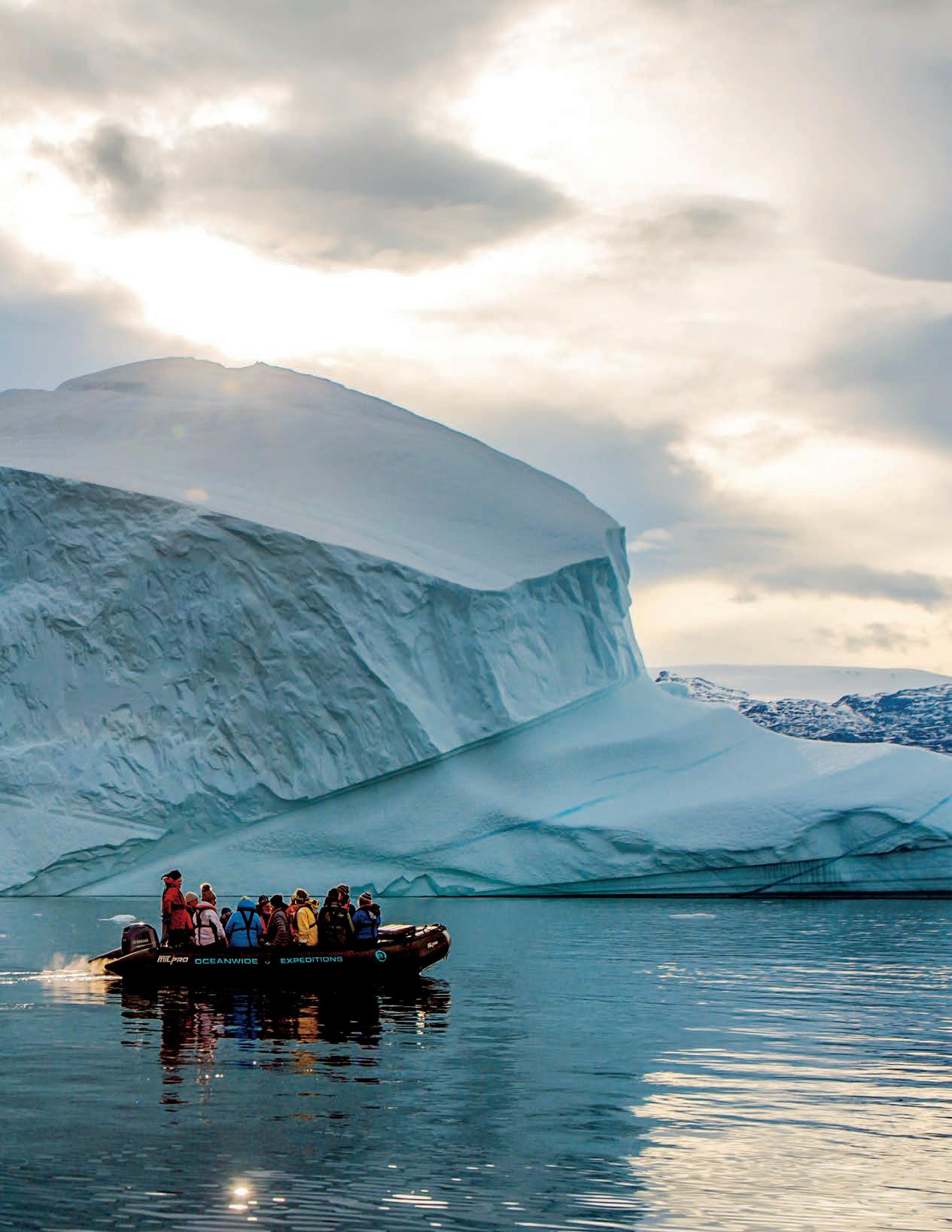
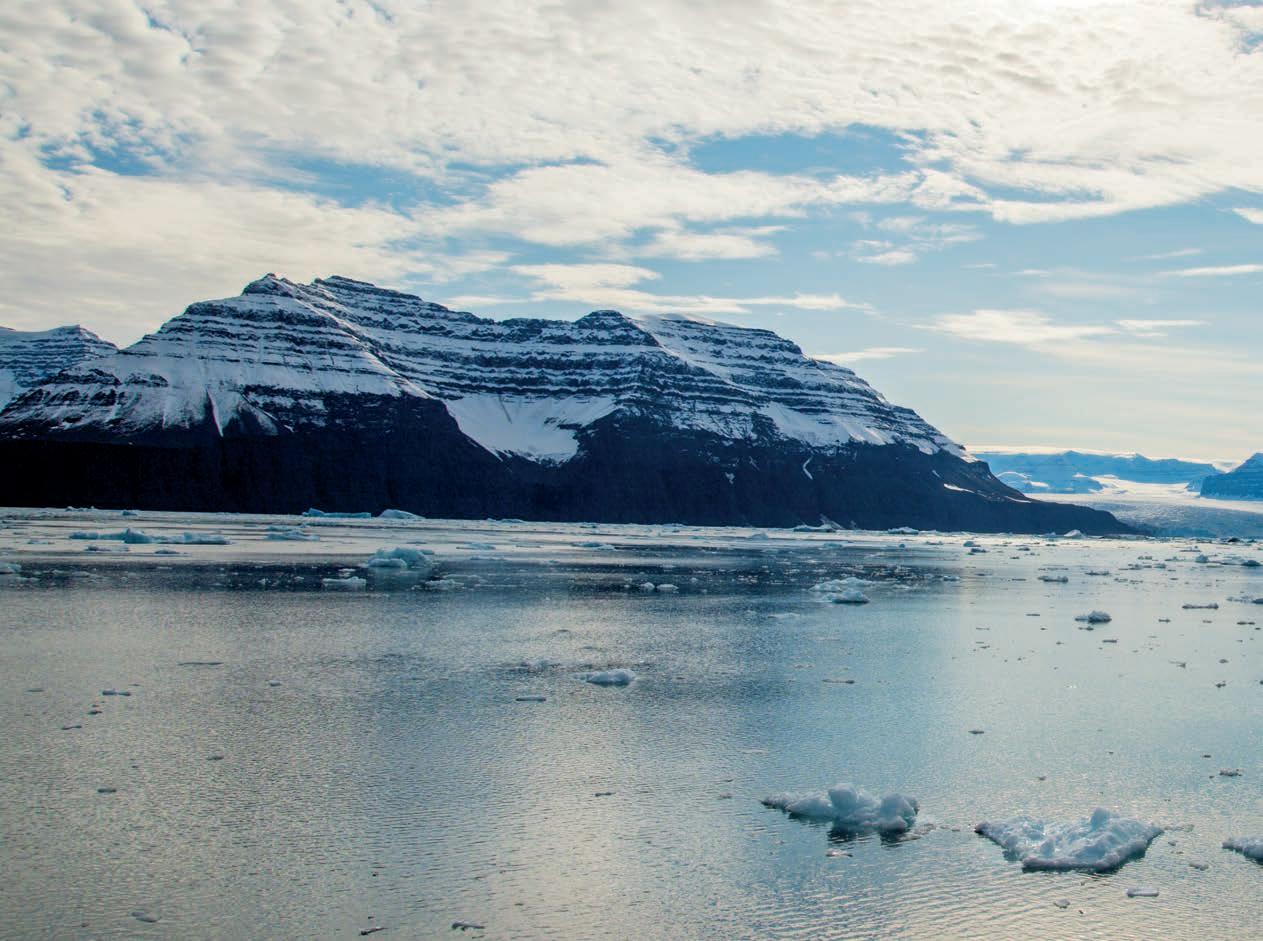
Ihave lived in Iceland for many years, so cold-water diving is very comfortable for me. I regularly dive in water as low as 33 degrees F and also dive under the ice in the winter here in Iceland. However, when an offer for a trip to Greenland with Blue Green Expeditions came up, I couldn’t say no to taking coldwater diving one step further.
Greenland is the world’s largest island (which is not a continent) at 836,000 sq miles, and with a population of just 56,000, you know that it’s going to be quite remote. Some 75 percent of the island is also covered by the only permanent ice sheet outside of Antarctica. During the winter, much of the sea around Greenland is covered in pack ice. Our trip took us to Scoresby Sund, on the east side of Greenland, during September when the pack ice has melted, leaving behind an incredible fjord filled with huge icebergs that have calved from the glacier. We departed from Akureyri in North Iceland and began the 24-hour journey onboard our home for the week, Plancius. It was built as an oceanic research vessel and now runs

The Greenlandic language is an interesting language, with a long history, and it’s closely related to the Inuit languages in Canada. ‘Kayak’ and ‘igloo’ are Greenlandic words that have been adopted directly by other languages.


trips to the Polar regions. The boat has 53 cabins and can accommodate 108 guests, and it also features some wonderful home comforts, such as a fine-dining restaurant and a bar.
In order to join a diving trip to Greenland, a good amount of serious cold-water diving experience is required. A minimum of 50 logged drysuit dives is needed, and I would highly recommend that as many of these are conducted in less than 50 degrees F as possible. Also, all your own personal equipment is needed, including drysuit, undergarments and two independent first stages that are environmentally sealed. All dive tanks here have two valves on them due to the risk of first-stage freezing and freeflowing regulators. We boarded at 3pm local time and settled into the boat for the overnight trip to Scoresby. Dinner on board was served and everyone began talking about the excitement of diving in Greenland. The diving here is mainly unexplored, and there are no dive site names or itineraries - this is true exploration in the Arctic.
During the first night on-board as we crossed the
Denmark Strait to get to Greenland, we were able to see the Northern Lights from the viewing deck - an incredible sight for all of the participants and an amazing start to the trip. To be able to stand under the glowing lights and know we were heading for unexplored diving and pristine seas created a real buzz among the travelers.
The following day we awoke to rough seas and experienced the power of the northern seas, with big swells all around us for most of the day as we continued north. In the late afternoon we entered the fjord and began to see the first small icebergs on the edge of the fjord, and as the sunlight retreated, we were again treated to another incredible Northern Lights show. The diving began the following day.
We were blessed to be greeting by perfect seas and mirror reflections the next morning, and as I made my way to the sundecks, I saw the first glimpses of the inner fjord. There was not a breath of wind, and the icebergs were as large as multi-storey buildings, perfectly reflected in the mirror-like surface of the fjord. TOP LEFT Majestic Greenland fjord
ABOVE When was the last time you got to hug an iceberg?
LEFT Now that is what you call icy-cold diving conditions
It is hard to describe the majesty of cruising slowly through the ice field, the icebergs are so serene and calm, yet hold thousands of years of history within them. The icebergs are simply beautiful. Also, knowing that usually around two thirds of the ’berg is actually underwater with only one third breaking the surface got us all excited for the diving.
We sat down for the morning dive briefing with the dive leader onboard, Henrik Enckell. Henrik has been diving for over 25 years in the world’s most-difficult conditions in both the Arctic and Antarctic, and is also a technical and rebreather instructor. He has a very calming voice and is a strong leader, which gave us great confidence heading in to dive unexplored waters. Henrik discussed with us the safety risks with extreme cold-water diving, freeflowing regulators, shutdown drills, drysuit flooding, hypothermia, etc, and set the tone for the group to realise this was serious cold-water diving.
We decided upon a shore/wall dive for the first dive. We loaded all the gear into the zodiacs and then headed down to meet them as they used a crane to lift them from the top of the ship. After rolling into the sea and being sharply woken by extremely cold water hitting our faces, we began the dive. The water here is around 33 degrees F and yet it was teeming with unexpected life. There were many colorful sea anemones, nudibranchs, jellyfish and sea stars - a perfect macro divers heaven.
For the afternoon we conducted a wall dive. On the wall we could see the basalt columns that we had seen above land also underwater, and were able to really study the geology of Greenland from the unexplored dive sites. The wall was covered with



FUN FACT! Greenland is an autonomous country within the Kingdom of Denmark.
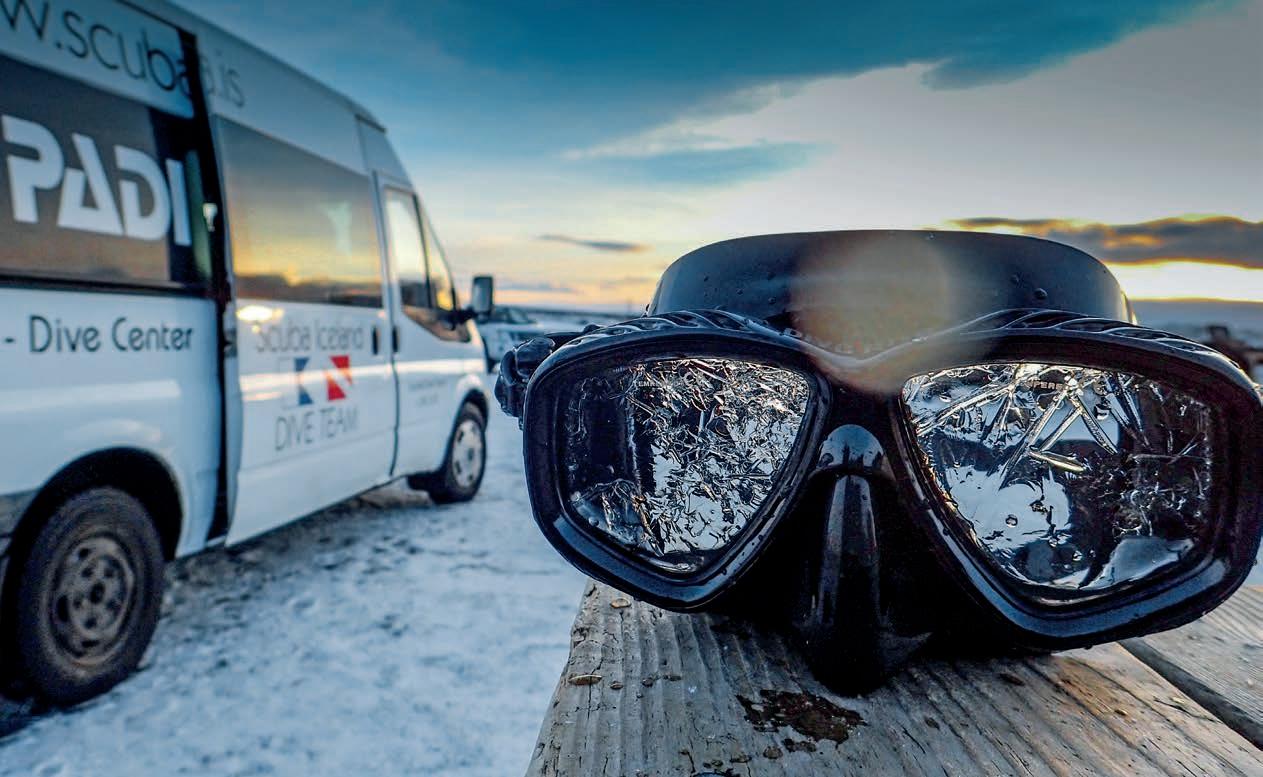
Drinking gin and tonics with ice cubes thousands of years old, it was amazing to reflect on the real exploration we had conducted on our visit to Greenland
beautiful anemones and all sorts of macro subjects, such as shrimps and sea slugs surrounding them.
After a few nice easy dives on day one, we settled in for the day two dive briefings with Henrik. Now it was time for what we all came for - diving under icebergs! Henrik guided us through the safety procedures, and also explained that the icebergs are made from fresh water and the sea is salt water, so as you approach the iceberg being weighted for salt, you then get around three feet from the iceberg and enter the area in which the ’berg is melting. This area is now fresh water, so as you approach if you don’t adjust your buoyancy, you will begin to sink underneath the iceberg! There are also sometimes caves within the icebergs which we were forbidden to enter. We also discussed the very real possibility of an iceberg flipping over during the dive.
We began the dive by rolling off the zodiac and breaking through the pancake ice on the surface. This is a thin layer of glass-like ice that floats all over the surface when the sea is flat calm. As we descended to the iceberg, we were greeted by good visibility at around 50ft. The iceberg was incredible to see underwater - the surface reminded me of a golf ball being dimpled.
To swim away from the ’berg and see it all was amazing. The texture and the shape, and also the fact that this was melting and in just a few weeks, this iceberg and dive site that was thousands of years old would no longer exist. We would be both the first people ever to see this underwater, and also the last. Later in the day we crossed the fjord and ended up in Jytte Haun for a real expedition dive to a place where nobody had been recorded diving before. The dive site was a wall with a slight current, and enabled us to do our first drift dive in the Arctic. We drifted along the healthy wall and were amazed by ABOVE You know it is cold when ice forms in your mask!
TOP LEFT Diving under the ice
MIDDLE LEFT Alongside an iceberg
LEFT Off on a shore excursion
While only 20 per cent of the land isn’t covered by the ice sheet, the remaining land lives up to the country’s name. The south of Greenland is technically at a lower, warmer latitude than Iceland, but unlike Iceland it doesn’t sit on the Gulf Stream.
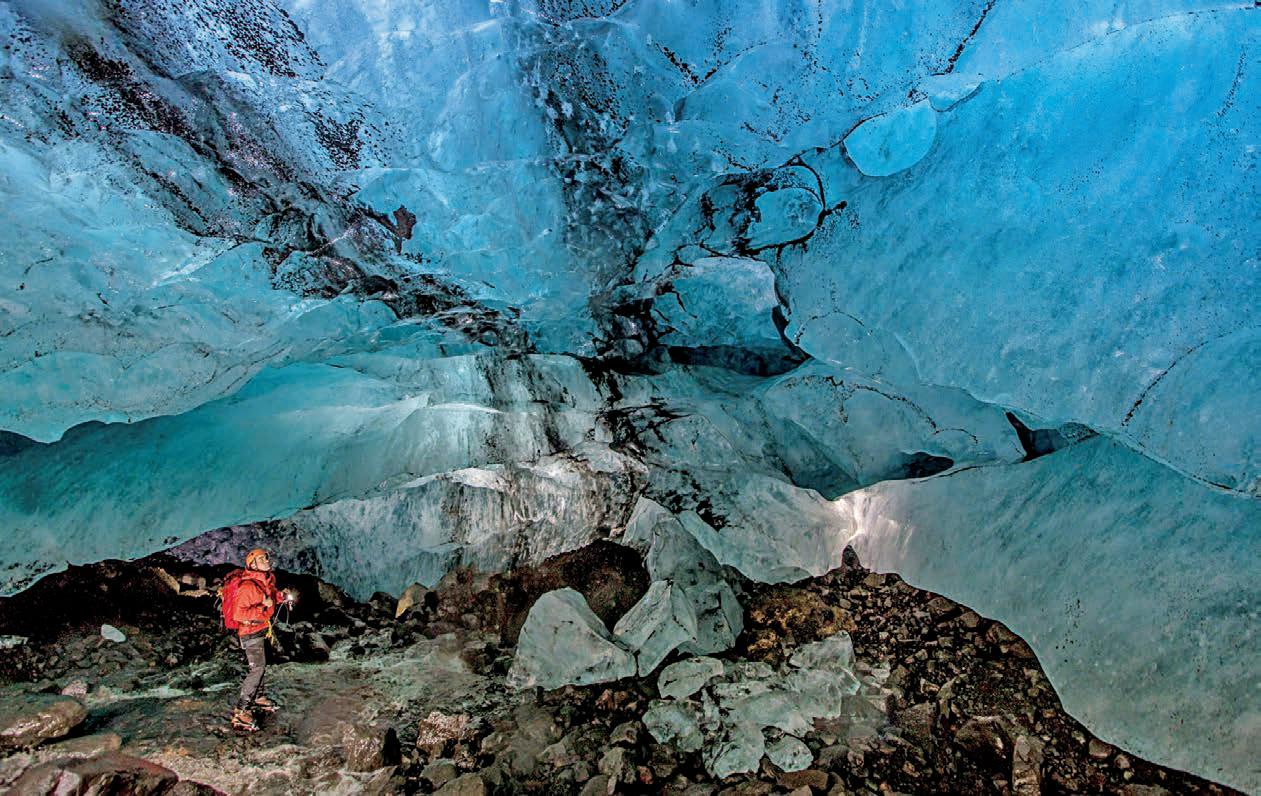
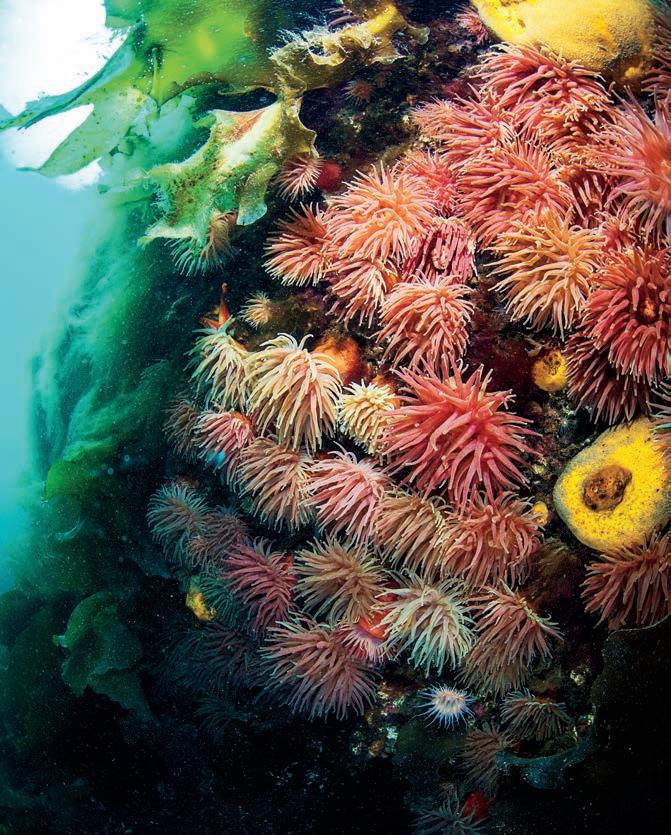
the abundance of life in this inhospitable place. There were lump suckers, anemones, jellyfish and many other fish and nudibranch species I had not seen before, even after years of diving the North Atlantic in Iceland. We also managed to take a zodiac trip around the fjord. This enabled us to get up close and personal to the iceberg and take some amazing photographs. To be next to an iceberg that’s bigger than a multi-storey apartment block was quite thrilling – plus we knew it could tip over at any time and create a big tidal wave! For day three of the diving, we headed towards Rode Island, where there was an iceberg graveyard. We were joined by some snorkelers and we went to explore an iceberg. This ice was different to the other ’berg we had dived, being completely see-through. With great visibility, it was possible to see divers through the ’berg on the other side - and also to see the rocks that had been frozen in time with the ice.
Our final days diving would just be one dive in the morning. After such a great day with the icebergs previously, we decided to conduct another wall dive with amazing macro photography options. In the afternoon we made a land excursion to the local town of Ittoqortoormiit… not the easiest town name I have ever heard! We were given the opportunity to stroll around this small settlement ourselves and enjoy the local town. It was great to be
FUN FACT! Greenland got its name from Erik the Red, an exiled Icelandic murderer, who called it ‘Greenland’ in hopes the name would attract settlers!
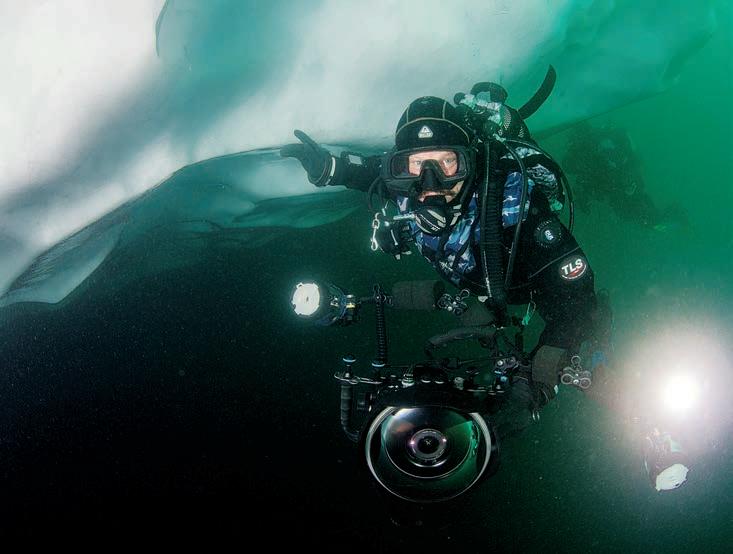
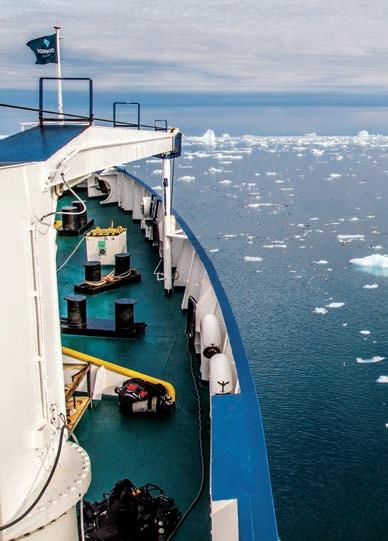

met by a local team member, who was able to stamp our passports with a Greenland stamp.
That evening we boarded our second home Plancius and began the cruise back to Iceland. The seas were more forgiving for the ride back and we were able to enjoy the home comforts of the boat. The guests were able to order drinks with ice cubes chipped away from a small iceberg that had been fished out of the sea. Drinking G&Ts with ice cubes thousands of years old, it was amazing to reflect on the real exploration diving we had conducted.
Greenland diving is not for everyone. The seas can be harsh, the temperatures extreme and the conditions tough, but the rewards of stunning topside scenery and the chance to be able to explore new dive sites and see icebergs that only you will ever see is quite appealing to the more-serious cold-water diver. n
TOP LEFT Inside a gigantic ice cave
TOP RIGHT An iceberg buddy
ABOVE Happy divers back in the RIB
LEFT Vibrant anemones add a splash of color
WHAT YOU NEED TO KNOW
Greenland
GETTING THERE Commercial airlines served by airports in Denmark and Iceland are the only way for travellers to get to Greenland – unless you arrive on a cruise ship or liveaboard.
WHEN TO GO The summer – the season of the Midnight Sun - is the optimum time to experience Greenland on both land and water, as the climate is generally mild and the weather can be fine for long spells.
CURRENCY Greenland is part of the Danish national community, and so the currency used is the Danish krone. Credit cards can be used at many hotels, restaurants and shops.
ENTRY REQUIREMENTS Travelers from the US and Canada just need a valid passport with six months left to expiry.
ELECTRICITY The standard voltage on Greenland is 230V, so visitors from the US and Canada will require a power-plug adaptor and a voltage converter.







